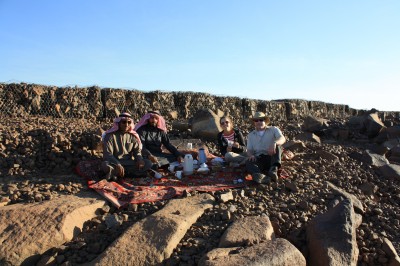
Anik Laferriere and Greg Fisher
By Nicole Findlay
When undergraduate student Anik Laferriere became a research assistant she expected to delve into the tomes of classical authors. What she didn’t anticipate was the whirlwind trip that took her half way around the world to the deserts of the Middle East with its ancient archaeological sites.
Laferriere, a student of religion in the College of the Humanities, recently returned from a research trip to Saudi Arabia and Jordan. The trip brought to life work she has been conducting under the direction of Greg Fisher, a professor of Greek and Roman Studies in the College of the Humanities.
“She is extraordinarily talented, dependable, reliable, competent, and hard-working,” said Fisher.
Fisher examines the northwestern part of the Arabian peninsula in the pre-Islamic period and its role as a frontier region for the Roman Empire in late antiquity. He has recently completed Between Empires: Arabs, Romans, and Sasanians in Late Antiquity and is currently working on a sourcebook on pre-Islamic Arabia, The Arabs Between Rome, Himyar and Iran.
“The main purpose of this trip to Saudi Arabia was to visit various archaeological sites that feature prominently in his work,” said Laferriere, also a research assistant for Fisher’s SSHRCC standard research grant.
After an initial visit to the King Saud University, the researchers embarked on the tour of ancient cities and sites, among these the old city of Riyadh, followed by a flight to al-Ula where they joined a French team excavating Madain Salih. They also visited two other sites, Ruwwafa, and Tayma, an oasis on an ancient trade route.
The trip was not without challenges. Laferriere was also struck by the cultural differences that exist between Canadian and Saudi Arabian attitudes towards women.
“Strict rules of conduct and dress for women made the trip, at times, difficult, but provided a lot of perspective for me on the lifestyles of women in the Middle East,” explained Laferriere. However, she found the restrictions lessened upon arrival in neighbouring Jordan.
There, Fisher and Laferriere visited three Roman forts, two churches, an 8th century city with both Roman and early Muslim ruins, the ancient Nabataean capital of Petra, two Qasrs, or mounds [in plural, qusur, and technically, castles or forts] and Mount Nebo, a Christian pilgrimage site at which Moses is said to have died.
“As a follow-up for this trip, Dr. Fisher and I are continuing our work on the sourcebook on pre-Islamic Arabia,” said Laferriere. She adds that having taken the trip and seen the sites, she now has a stronger connection to her work.
“The trip provided me with a renewed interest in the uses of Christianity in the development of political and social relationships in the Roman Empire.”
Laferriere has won a coveted Clarendon scholarship to Oxford for 2011-13.